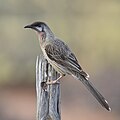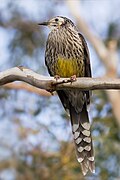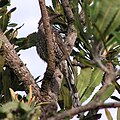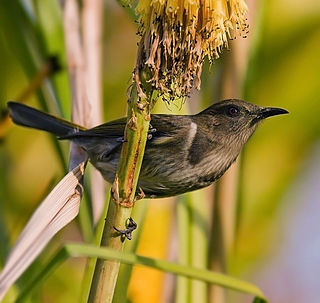
The honeyeaters are a large and diverse family, Meliphagidae, of small to medium-sized birds. The family includes the Australian chats, myzomelas, friarbirds, wattlebirds, miners and melidectes. They are most common in Australia and New Guinea, and found also in New Zealand, the Pacific islands as far east as Samoa and Tonga, and the islands to the north and west of New Guinea known as Wallacea. Bali, on the other side of the Wallace Line, has a single species.

The regent honeyeater is a critically endangered bird endemic to southeastern Australia. It is commonly considered a flagship species within its range, with the efforts going into its conservation having positive effects on many other species that share its habitat. Recent genetic research suggests it is closely related to the wattlebirds.

The red wattlebird is a passerine bird native to southern Australia. At 33–37 cm in length, it is the second largest species of Australian honeyeater. It has mainly grey-brown plumage, with red eyes, distinctive pinkish-red wattles on either side of the neck, white streaks on the chest and a large bright yellow patch on the lower belly. The sexes are similar in plumage. Juveniles have less prominent wattles and browner eyes. John White described the red wattlebird in 1790. Three subspecies are recognized.

The double-barred finch is an estrildid finch found in dry savannah, tropical (lowland) dry grassland and shrubland habitats in northern and eastern Australia. It is sometimes referred to as Bicheno's finch or as the owl finch, the latter of which owing to the dark ring of feathers around the face. It is the only species placed in the genus Stizoptera .
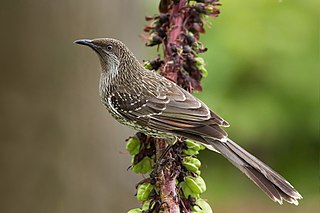
The little wattlebird, also known as the brush wattlebird, is a passerine bird in the honeyeater family Meliphagidae. It is found in coastal and sub-coastal south-eastern Australia.
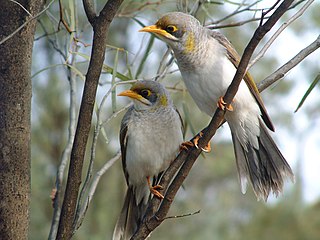
Manorina is a genus of Australian endemic honeyeaters, containing four species: the black-eared miner the yellow-throated miner, the noisy miner and the bell miner. The genus is notable for the complex social organisation of its species, which live in colonies that can be further subdivided into coteries and nest contingents.

The blue-faced honeyeater, also colloquially known as the Bananabird, is a passerine bird of the honeyeater family, Meliphagidae. It is the only member of its genus, and it is most closely related to honeyeaters of the genus Melithreptus. Three subspecies are recognised. At around 29.5 cm (11.6 in) in length, the blue-faced species is large for a honeyeater. Its plumage is distinctive, with olive upperparts, white underparts, and a black head and throat with white nape and cheeks. Males and females are similar in external appearance. Adults have a blue area of bare skin on each side of the face readily distinguishing them from juveniles, which have yellow or green patches of bare skin.

Spinebill is the name given to two members of the honeyeater family, both in the genus Acanthorhynchus, which is Latin for "spine bill". They are around 15 centimetres in length, and are coloured black, white and chestnut, with a long, downcurved bill. They are native to Australia, with one species in the east and one in the west. They feed on nectar as well as insects, and live mainly in forests, gardens, and other shrubbery habitats.

The black-faced monarch is a passerine songbird in the family Monarchidae found along the eastern seaboard of Australia, and also New Guinea.

The white-naped honeyeater is a passerine bird of the honeyeater family Meliphagidae native to eastern Australia. Birds from southwestern Australia have been shown to be a distinct species, Gilbert's honeyeater, and the eastern birds are more closely related to the black-headed honeyeater of Tasmania. One of several similar species of black-headed honeyeaters in the genus Melithreptus, it dwells in dry sclerophyll eucalypt woodland. Its diet consists of nectar from various flowers, and it also feeds on insects.

The black honeyeater is a species of bird in the honeyeater family Meliphagidae. The black honeyeater exhibits sexual dimorphism, with the male being black and white while the female is a speckled grey-brown; immature birds look like the female. The species is endemic to Australia, and ranges widely across the arid areas of the continent, through open woodland and shrubland, particularly in areas where the emu bush and related species occur.

A shrikethrush, also spelled shrike-thrush, is any one of eleven species of songbird that is a member of the genus Colluricincla. They have nondescript, predominantly brown or grey, plumage, but are accomplished singers, their calls described as "strong, mellow and beautiful." Shrikethrushes are generally insectivorous, though have been recorded eating molluscs and berries. They build cup-shaped nests in the forks of trees.

Drymodes is a genus of bird in the family Petroicidae. It was traditionally held to have two species, but molecular and behavioural differences led to the split of the New Guinea populations from the northern scrub robin. The paper by Les Christidis and colleagues was published in 2011 and the IOC adopted the split in 2015:

Epthianura is a genus of bird also known as the Australian chats. Along with the gibberbird in the genus Ashbyia they were once thought to constitute a separate family, the Epthianuridae, although most taxonomists today treat them as a subfamily, Epthianurinae, of the honeyeater family Meliphagidae.

The tawny-crowned honeyeater is a passerine bird native to southern Australia.

The black-headed honeyeater is a species of bird in the family Meliphagidae. It is one of two members of the genus Melithreptus endemic to Tasmania. Its natural habitats are temperate forest and Mediterranean-type shrubby vegetation. Despite its name, the black-headed honeyeater eats predominantly insects.

The strong-billed honeyeater is a species of bird in the family Meliphagidae. It is one of two species of the genus Melithreptus endemic to Tasmania. Its natural habitat is temperate forest.

Myzomela is a genus of bird in the honeyeater family Meliphagidae. It is the largest genus of honeyeaters, with 40 species, and the most geographically widespread. It ranges from Indonesia to Australia and into the islands of the Pacific Ocean as far as Micronesia and Samoa.
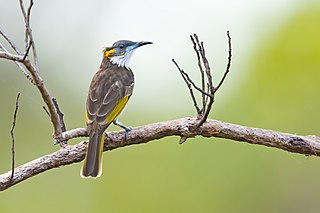
The white-streaked honeyeater is a species of bird in the family Meliphagidae. It is monotypic within the genus Trichodere. It is endemic to Cape York Peninsula in Queensland, Australia. Its natural habitat is subtropical or tropical dry forest.

Ptilotula is a genus of honeyeater consisting of species occurring in Australia and Papua New Guinea. The genus consists of six former members of Lichenostomus, and was created after a molecular analysis showed the genus was polyphyletic. The International Ornithologists' Union accepted this change and officially included the genus in reference lists from 2013. The type species is the yellow-tinted honeyeater. Birds in this genus typically occupy dry open forest and woodland habitats, and can be found in arid and semi-arid environments.

